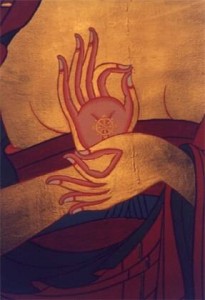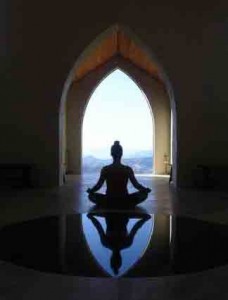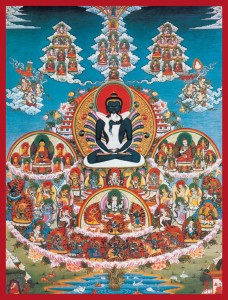A Video teaching by Jetsunma Ahkon Lhamo
Uncategorized
Right Livelihood
An excerpt from a teaching called the Eightfold Path by Jetsunma Ahkon Lhamo
Right livelihood is in the ethical conduct section of the Eightfold Path, and it means that one should earn one’s living in a righteous way. Wealth should be gained legally, and peacefully. It sounds pretty simple, but it’s not so simple in today’s world, because you really have to look at what you do. Lets say you own a liquor franchise. You might want to think about selling that business and going into the Tofutti business. You know? If you think about it, many people suffer due to what your product is. Maybe you’re making lots of money at your liquor establishment, but then you see the poor people stumble back and forth on your street, and you have just got to ask yourself, are you doing the right thing? Upon contemplating right livelihood, one will come to understand that this is not correct. This is not a good way to make one’s money. Sell the franchise, and go into Dunkin Donuts or something, they make a decent coffee. Something even better would be something that benefits sentient beings like a health food or some other product. Right livelihood is like that.
The Buddha mentions four specific activities that harm other beings that one should avoid for this reason. Dealing in weapons. They hurt. Dealing in living beings, which includes the slave trade, prostitution, and raising animals for slaughter. That is wrong livelihood. It is wrong to the core of the path. No one should ever enslave another being. No one should ever raise beings to die. This is what the Buddha has taught, and to the degree that we go against that and harm sentient beings in this way, we ourselves will be harmed, if not in this lifetime, then in the next lifetime. I tell you, folks. What goes around comes around.
More wrong livelihood that should be avoided is working in meat production and butchery, as well as selling intoxicants and poisons, such as alcohol and drugs. Furthermore, any other occupation that would violate the principals of right speech and right action should be avoided, so again there’s that blend. Right speech, right action, they are both in that ethical category.
Ethics are so important and they are really not taught in many religions. And in fact if you go right to Vajrayana, you may even miss these teachings. But ethics are the foundation, the underpinning of the path. You cannot go into highfalutin practice without good ethics. Your whole house will fall apart. It will be like a house of cards. We start here in the world, here in the mirror, looking at ourselves. Taking account before we go onto the fancy stuff. You must examine your own methodologies, and to make sure that you have established good ethics and right view.
© Jetsunma Ahkon Lhamo
Practicing Kindness and the Dharma Warrior
Practicing Kindness and the Dharma Warrior: YouTube video teaching by Jetsunma Ahkon Lhamo
Lead Your Mind to a Pristine Point
From a series of tweets by Jetsunma Ahkon Lhamo (@jalpalyul)
Our minds have been under the influence of delusion since the beginning of time. The function of concentration is to gain control of our minds. Having gained control of the mind we can then steer it in a virtuous direction. Without mind training this is not possible. Without training the mind will continue to be like “monkey mind” that drags one around in an unstable way. This is very detrimental to one’s path. Because of that we have indulged in negative actions. These actions lead to unwanted suffering. Therefore if we wish to succeed on the path we must learn to transform and gain control of our minds.
Like a donkey, the mind must be led in a virtuous direction and used as method as one would ride a horse. One cannot allow the mind simply to wander. The mind’s habit is to wander wherever, and acts like a monkey, distracted and hyper, enjoying shiny things! When you make real progress, you should be able to place the mind at a pristine point easily and well. Until one attains that point, it is necessary to progress step-by-step. One must build a house with stable walls by building a perfect stable foundation. This is the way pure Lamas do, and we, of course must follow!
© Jetsunma Ahkon Lhamo
Who Needs Refuge?
The following is an excerpt from a teaching by Jetsunma Ahkon Lhamo called “Faults of Cyclic Existence”
How is the understanding of compassion a clarifying thought as well as a motivating thought? How is it a clarifying thought? Now here is where the profound connection with refuge comes into play. Not only does the compassion motivate us to take refuge, but it makes us think it through very clearly. If we utilize it, it does.
When we enter onto the path of the Buddhadharma, we take refuge in the outer refuge of Buddha, Dharma, Sangha, the inner refuge of lama, yidam, khandro, and the secret refuge of the channels, winds and fluids. When we actually enter into this refuge, which for our purposes now are the Buddha, Dharma and Sangha, Triple Gem refuge, we must define why it must be arranged the way it is. Why is it organized the way it is? For instance, if it’s true that all sentient beings are suffering but they wish to be happy and they are mostly suffering due to desire and the confusion about issues concerning desire, if that’s what the Buddha said, then why don’t we just kind of sit down and have a therapeutic session of insight so that we can isolate for ourselves what it is that we actually want.And maybe then we can go and get it. If all sentient beings are really suffering and we’re really unhappy and we’re trying to be happy, why don’t we just have an insight of some kind and go for it!? Why don’t we do that? Well, because you’ve done that before. You’ve done that before. You do it all the time to greater or lesser degree, according to your capacity and your habitual tendency. In fact, we do that all of the time. We feel a need. We feel desire. We feel something. Something is moving that locomotive down the track. What is it? So we sit down and we try to center ourselves or we get busy and allow thoughts to come up. Each one of us has a characteristic way to deal with things. Maybe we’ll do a little journaling, we’ll do a little art, we’ll do a little music, we’ll do a little whatever, take a walk and try to center ourselves, and figure out what’s going on. Well, we’ll come up with something. You always come up with something
Now we’re going to figure out, “Oh , if I don’t get with the great love of my life pretty soon…, That’s what it is, I know that’s what it is.” So now you’re on to the next adventure. Or you may ask yourself,“What is it that’s troubling me? What is it that’s troubling me?” And you sit down and you’re reaching inside and using all this psychological technique and you’re going, “Oh it’s my mother!!! My mother didn’t love me!!” Each of these are valid. I’m not saying that these are not issues in your life. I’m not saying that these are not valid things to think about, but I am saying that there is some confusion there in that you are looking at the superficial causes for discomfort, but not the deeper ones.
If we were to look more deeply,, we would discover that the underlying cause of all suffering is desire, and that we’re real, real, real confused about this whole issue. So we examine the path and examine the teachings a little bit further. And we find that the Buddha has taught us that samsara is actually made up of the things that potentially make us suffer. That is to say that the first step or connection with samsara, that is the wheel of death and rebirth, is based on the idea, the first gossamer thin assumption or idea, of self-nature as being inherently real. Why does that happen? That happens because it can. End of subject. It’s one of the potentials in the great ground of primordial nature which contains within it all potentials. So this has happened. We have considered ourselves separate.
In order to consider one’s self as self nature separate, other has to be external. In order for other to be external, it has to be determined. In order for it to be determined, we have to react toward it. There has to be a reaction toward it with acceptance or rejection. You cannot see something without registering acceptance or rejection, or the combination of the two, which is neutrality. Neutrality is not lack of reaction. It is a combination of reactions. So we cannot experience anything as outside ourselves without some sort of reaction. And once that has happened, we react toward everything with hope and fear.
So everything in samsara is then built from that original structure of the idea of self nature being inherently real and at this point one’s self is determined, and other becomes external. We split into subjective-objective reality. Everything in samsara, every kind of perception with the senses, anything that we take in with our eyes, our ears, our tongues, anything that senses, comes from, at the root, that original construct, that original assumption of self-nature as being inherently real. So everything in samsara is built of that. That is to say that nothing that we experience now, nothing that we have ever experienced, is separate from the realm of desire. So literally, everything within samsara is potentially cause for more suffering.
Copyright © Jetsunma Ahkon Norbu Lhamo All rights reserved
The Trap of Intellectual Satisfaction
The following is an excerpt from a teaching by Jetsunma Ahkon Lhamo called “Perception”
So, if you are conscious, does that lead you to the assumption that self-nature is real? Yes, it does. Of course it leads you to the assumption that self-nature is real. What are you doing here if you don’t think self-nature is real? I mean, be real. Why are you sitting here listening to this teaching so that you can attain realization in order to benefit beings? The whole thing is built on the assumption of self being real. I mean, you go to work every day. Would you go to work if self wasn’t real? It doesn’t make any sense at all, does it? Would you go through what you go through if self wasn’t real?
So, self is real. Where we get into trouble is when we try to find self. If you go through the process that I have described, and if you really do it diligently, if you follow that process and follow it faithfully, you will become extremely confused because then you will not know who is being confused. It will be clear to you, very clear to you, that self is not to be found.
Well, what do you do with this, I mean, really? What you’re supposed to do with this is meditate because if you try to do this with your brain, first of all, you’ll be crazy within a week. It simply won’t work. You can come to some conclusions. One thing about the Buddha’s teaching is that the philosophy is extremely appealing to the intellect. A lot of what the Buddha taught was made for very intellectual people. It was made to be sifted through and reasoned out intellectually. The Buddha’s instructions were that we should not practice anything that’s not reasonable to us and intelligent, so you must reason it out for yourself. There are even some arguments that are used about reincarnation. One can sum it up by saying that to have only one lifetime that continues into infinity is about as logical as postulating a stick with one end. It’s not logical. It does not seem as though it could be possible, or it does not seem as though it could be realistic.
So when it comes to this kind of philosophy that we’ve been learning about, one should really think on these things. Let’s say that we contemplate a little bit on this, and we come up with the dilemma that our experience is very real. I am having an experience, there’s no denying it and yet, when I come to find self, I cannot find it.
So, we might, because we’re Westerners, and because this is a habitual tendency of Westerners, and also because we are confused and deluded and sentient beings, we might want to get into this meaty kind of inner dialogue with ourselves. We might want to say to ourselves, “If I can’t find self and yet I am clearly feeling and touching and tasting and smelling and I clearly am conscious, what is happening here?”
Now if I listen to the Buddha’s teachings, and I say to myself, “Well, the Buddha teaches us that this is all a function of the assumption that self is real. Everything that I perceive seems extremely real to me, and yet it is a function, just like my fingers are a function of my body. In that same regard and with that same directness, these experiences that I’m having are actually the extensions of perception that I’m having, and the perceptions themselves are actually a function of the assumption of self. Yet, I can’t find the self, and the Buddha said, in fact, my nature is empty of self.” We might get into the trap of trying to figure out who made the assumption.
Don’t you love that question? You would love to hear the answer. What if I told you that if you paid me two hundred dollars apiece I would tell you the answer to that question. You might do it! But actually, the Buddha did not teach, really, the answer to that question. The Buddha recommended that we don’t waste our time concentrating on our ability to compute and understand some occurrence that, perhaps or perhaps not, happened in time out of mind. He recommended that we do not waste our time with philosophical questions. And the reason why we should not waste our time with such philosophical questions is that they do not lead to enlightenment, or in fact, to growth of any kind.
To have these questions answered and to be satisfied with them, one plays with them in the intellect. One uses them as toys. They’re interesting baubles to juggle. Every moment that you juggle these interesting baubles, you increase your awareness of consciousness, you increase the awareness of intellect, you deepen the self-cherishing, the clinging to self-nature as being inherently real.
Copyright © Jetsunma Ahkon Lhamo. All rights reserved
The Compassionate World of His Holiness Penor Rinpoche
A video of the Compassionate Activities of His Holiness Pema Norbu Rinpoche with permission from Pathgate Institute of Buddhist Studies, and special thanks to Lama Dondrup Dorje
Buddha In The Palm of Your Hand
From a series of tweets on October 20, 2010 by Jetsunma Ahkon Lhamo
A few precious words taught by Kyabje His Holiness Penor Rinpoche.
The great master Buddha gave three main sermons to lead sentient beings onto the Path of Liberation from the suffering of samsara. Because beings have different levels of mind and interest, Buddha has given the teachings in nine Yanas or paths. These nine paths can be divided into the paths of Hinayana and Mahayana. Mahayana includes both Sutrayana, which emphasizes the practice of Bodhicitta and the six perfections, and Vajrayana, which utilized the techniques of deity meditation and skillful means of attaining Enlightenment.
The first eight Yanas are steps to the last and highest Yana called Atiyoga in Sanskrit. Ati means the best, top or essence. Yoga refers to the practitioner. Dzogchen, the practice of Atiyoga leads the practitioner directly to Enlightenment.
The Namcho (Space Treasure) Dzogchen preliminary practice is called “Buddha in the Palm of Your Hand.” By accomplishing this practice one can realize the nature of mind. An important and necessary foundation for higher Dzogchen practice, the preliminary practice consists of several steps.
Refuge or entering the gate of the three precious Jewels; Bodhicitta, the practice of the six perfections and the generation of the aspiration to realize Enlightenment; offering the Mandala, the accumulation of merit through skillful means; Vajrasattva, the purification of obscurations through Wisdom; and Guru Yoga, receiving the blessing through which one can attain Enlightenment in a single lifetime.
All components are necessary, as the Lama provides the maturation of the mind or there is little result. This Cycle of Revelation was revealed by Terton Migyur Dorje, who received it from Arya Avelokiteshvara and Guru Rinpoche.
This was from Kyabje Penor Rinpoche. With great longing, I bow down.
© Jetsunma Ahkon Lhamo
What Is Real?
From a series of tweets by Jetsunma Ahkon Lhamo
In science we have learned that objects, indeed, people are mostly space. We have atoms and molecules, and between them is empty space. So it is the case as Buddhism states. The primordial ground of being is the self-originating empty luminous state – space.
All appearances are due to the five senses, which are the five grasping skandas. We perceive by these senses all phenomena. The senses are themselves empty of self-nature.
So what is real? That empty, luminous uncompromised ground nature, and even THAT is empty if it is attached to conceptualization. It is natural vibrational attraction, magnetism so subtle that holds “view” together. We can also say that habitual tendencies, KARMA, cause and effect that rules view and condition; phenomenal display. In short we see what we are and according to habit from birth AND before. A cat is a born predator. A rabbit is born prey. Thus it is taught that every thought and action are important as they create every future, and result.
If we intentionally direct our minds toward harm, we ourselves will see the result. Cause and result. If not in this life, then soon. We are dancing in vibrationally-tuned luminosity. Every cause has result. And this is the Karma we bring into our future lives.
Try hard, indeed, accomplish virtue and view. And steer clear of harming others and causing suffering. This is what Lord Buddha taught. Eh Ma Ho.
In the end we will ALL suffer if we harm others. If we cultivate virtue (not just for show) we can benefit beings and know true bliss! Om Ah Hung Benzar Guru Pema Siddhi Hung
© Jetsunma Ahkon Lhamo
A Wish Fulfilling Jewel
If you have ever walked into the Prayer Room at Kunzang Palyul Choling, you cannot have helped but notice the large collection of crystals. And perhaps you have wondered, “Why do they have all of these crystals? Is this typical of Buddhism? What is their purpose?”
The Mineral Kingdom on a Mission:
The world is filled with uncountable minerals – crystals, ores, and gems. Not only are they beautiful to behold, but they actually serve a vital function of maintaining the vibratory structure of the universe. Originally brought into manifestation by rays of tone and color and vibration originating from the Primordial State of Awareness (the Absolute), they assure true communication and transmission of divine energies. Crystals function to transmit peace, love, absolute oneness, absolute awakened consciousness. They help to remind human kind of our own true nature, which is not unlike the clearest crystal and not unlike the most beautiful and radiant gems.
Each mineral or family of minerals has a specific attunement with different aspects of the Primordial Wisdom State that is the nature of all things. If they were not present on our planet, many divine qualities would be lost to our memory. But no mineral creates energy of its own. They are transmitters, attuned to the cosmos. They tend to refract universal energies into specific qualities. If it seems that a crystal creates energy, it is because it has touched the Infinite and speaks of it, as though it had heard a song and continues to sing.
It is with this understanding that the crystals at KPC are utilized and upheld. Walking through the Temple you will see magnificent specimens of all types: clear and smokey quartz, rose quartz, amethyst, citrine, tourmaline, apophyllite, elestials, and so on. Each type of mineral has a specific attunement to the Primordial State of Awareness, and together they work to absorb and amplify prayer energy and the presence of this primordial awareness (Buddhanature or God-consciousness) into the world. Since 1985 KPC has maintained a 24-hour-a-day Prayer Vigil for the planet and all beings and the crystals are considered a vital part of our efforts.
How Do Crystals Fit Into Tibetan Buddhism?
While KPC is distinctive among Buddhist Centers in the number and unique use of crystals, they are indeed utilized within the Tibetan Buddhist Tradition. In Tibetan Buddhist empowerment, the Lama will confer a special ‘nature of mind” transmission, wherein he holds up and students gaze upon a perfectly clear quartz crystal, symbolic of our Primordial Wisdom Nature. Prayer beads (or malas) are also often made of semi-precious stones, from quartz to lapis lazuli, to amethyst. The mala is blessed and empowered by one’s teacher, and serves as an aid to one’s spiritual practice.
Crystals, whether individual stones or prayer beads, in conjunction with a tried and true spiritual path can act as catalysts – bringing forth and ripening latent karmic potentials within your mind. They may facilitate meditation and the breaking up of basic delusion. But ultimately no mineral can give you anything that you don’t already possess. They are supports to the spiritual path, not objects of refuge themselves. On the path to enlightenment we have to find a way to catalyze the things that are most helpful to us, and that’s what crystals do. That’s what they will do for a practitioner. They should be an aid in our remembering – a support to realizing our true nature.
Something Truly Special
KPC’s crystals were chosen for their unique energies and strategically placed in order to facilitate the anchoring and transmission of prayer energy into the world. Our spiritual director, Jetsunma worked to merge the energy of the crystals with one another and with the compassionate Buddha Nature. Through twenty five years of continuous, unbroken prayer, the crystals have supported the mission of KPC and Jetsunma’s vision to bring benefit to countless sentient beings.








